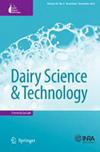在过渡期消除自由栏头锁与产奶量、健康和繁殖性能的关系:一个案例报告
Q2 Agricultural and Biological Sciences
引用次数: 0
摘要
本回顾性案例研究的目的是了解在一个大型奶牛群中,消除产后21天的自由栏锁定时间对产奶量、繁殖性能和健康事件的影响。选取200头奶牛作为治疗组(TRT),在泌乳早期不进行锁乳时间,另设200头奶牛作为对照组(CON),平均每天进行2 h锁乳时间。TRT组在每月泌乳试验第3天产奶量(平均±SE)更高(33.1±0.75∶29.9±1.22;P = 0.04),且在试验第2天产奶量更大(38.3±1.55∶39.1±0.79;p = 0.06)。第一次月乳试验时,TRT组乳脂%(平均值±SE)高于CON组(3.65±0.06∶3.31±0.12,p = 0.01)。TRT组在第一个月乳试验日的线性体细胞评分低于CON组(2.6±0.24∶3.2±0.11;P = 0.01)。TRT组奶牛初产乳天数(DIMFB)较低(66.2±3.7∶76.7±2.9);p = 0.02),且哺乳期至妊娠天数较短(DIMPREG)(96.9±12.32∶112.1±5.5;P < 0.01)。TRT组的奶牛所有健康事件的发生率也较低(13% vs. 30.5%;P < 0.001),跛行(3%比9.5%;P = 0.01),乳腺炎(3% vs. 16%;P < 0.001)。我们得出的结论是,消除牛栏锁定可能有助于提高奶牛的产奶量、健康和繁殖性能。未来的前瞻性队列研究需要进一步评估消除锁定时间对奶牛生产性能的潜在影响。本文章由计算机程序翻译,如有差异,请以英文原文为准。
Associations of Eliminating Free-Stall Head Lock-Up during Transition Period with Milk Yield, Health, and Reproductive Performance in Multiparous Dairy Cows: A Case Report
The objective of this retrospective case study was to understand the effects of eliminating free-stall lock-up time during 21 days postpartum on milk yield, reproductive performance, and health events at a large dairy herd. A group of 200 cows were selected as the treatment (TRT) group, which did not receive a lock-up time during early lactation, and a separate group of 200 cows served as the control (CON) group, which received on average 2 h/day of lockup time. The TRT group had greater milk yield (mean ± SE) on the third monthly milk test day (33.1 ± 0.75 vs. 29.9 ± 1.22; p = 0.04) and tended to have greater milk yield on the second test day (38.3 ± 1.55 vs. 39.1 ± 0.79; p = 0.06) compared to the CON cows. Milk fat% (mean ± SE) was greater in the TRT group than in the CON group on the first monthly milk test (3.65 ± 0.06 vs. 3.31 ± 0.12, p = 0.01). The TRT group had lower linear somatic cell scores on the first monthly milk test day compared to the CON group (2.6 ± 0.24 vs. 3.2 ± 0.11; p = 0.01). Cows in the TRT group had lower days in milk at first breeding (DIMFB) (66.2 ± 3.7 vs. 76.7 ± 2.9; p = 0.02) and were confirmed pregnant earlier as indicated by smaller days in milk to pregnancy (DIMPREG) (96.9 ± 12.32 vs. 112.1 ± 5.5; p < 0.01). Cows in the TRT group also had fewer incidences of all health events combined (13% vs. 30.5%; p < 0.001), lameness (3% vs. 9.5%; p = 0.01), and mastitis (3% vs. 16%; p < 0.001). We conclude that eliminating the stall lockup may have contributed to the increased milk yield, health, and reproductive performance of dairy cows in this dairy herd. Future prospective cohort studies are needed to further assess the potential effect of eliminating lock up time on cow performance.
求助全文
通过发布文献求助,成功后即可免费获取论文全文。
去求助
来源期刊

Dairy Science & Technology
农林科学-食品科技
CiteScore
2.30
自引率
0.00%
发文量
0
审稿时长
2 months
期刊介绍:
Information not localized
 求助内容:
求助内容: 应助结果提醒方式:
应助结果提醒方式:


